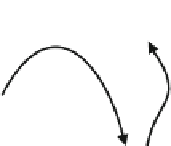Information Technology Reference
In-Depth Information
the actions of the agent Ag
2
changing the state of the environment x
0
The agent Ag
1
observes the
environment
and builds
the model
m
1
f
1
(…)
f
2
(…)
x
1
m
1
x
2
x
0
Ag
1
Ag
2
Fig. 2.19
Schema of actions of the algorithm of the agent on the basis of the model of the
environment. The agent
A
g
1
on the basis of observation of the environment builds the model
m
1
with which it may define the internal state of the agent
A
g
2
These considerations lead to the following scenario of actions of agent:
•
The function realizing the actions of the agent
A
g
1
must use the data
x
1
defining
the state of the agent, the data applying to the state of the environment (global
data)
x
0
, as well as the data
x
2
of the agent
A
g
2
.
•
In order to gain information defining
x
2
, the agent
A
g
1
observes the behaviour of
the agent
A
g
2
(Fig.
2.19
), i. e., the agent
A
g
1
registers changes which are made by
the agent
A
g
2
in the environment (
x
0
). The task of this observation is to build by the
agent
A
g
1
the model
m
1
of its surrounding environment, which makes it possible
to receive indispensable information on local data
x
2
of the agent
A
g
2
(the model
m
1
will be discussed in details further in later chapters). It should be emphasized
that the agent
A
g
1
may realize its observation (and on that basis the construction
of the model
m
1
) independently of the agent
A
g
2
. When data are received from
the observation of the environment (about the agent
A
g
2
) do not give complete
information on the state of the agent
A
g
2
(data
x
2
), they may be replaced with
approximate data (received from the analysis of the model
m
1
).
•
The agent
A
g
1
, which makes use of the model
m
1
, may foresee states of other
algorithms (agents) cooperating in the system and make appropriate decisions
concerning its action in the agent system.
•
Having all the necessary data the function
f
1
of the agent
A
g
1
realizes an appropriate
action which results in the modification of the state of the agent
x
1
and the state of
the environment
x
0
(which is not shown in Fig.
2.19
). The situation may change
and, now it is the agent
A
g
2
that observes the changes of the environment made by
the agent
A
g
1
, and on this basis builds itsmodel
m
2
. Accordingly, the agent
A
g
2
may
change its state (
x
2
) on the basis of the model realized with the use of observation
of changes of the environment (
x
0
) evoked by the action of the agent
A
g
1
.





